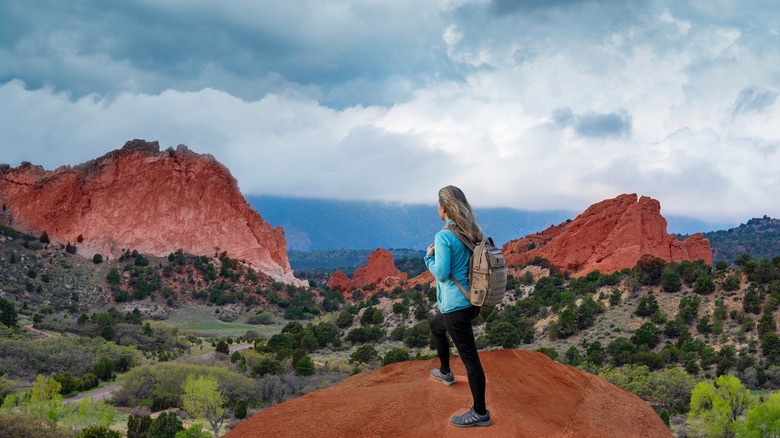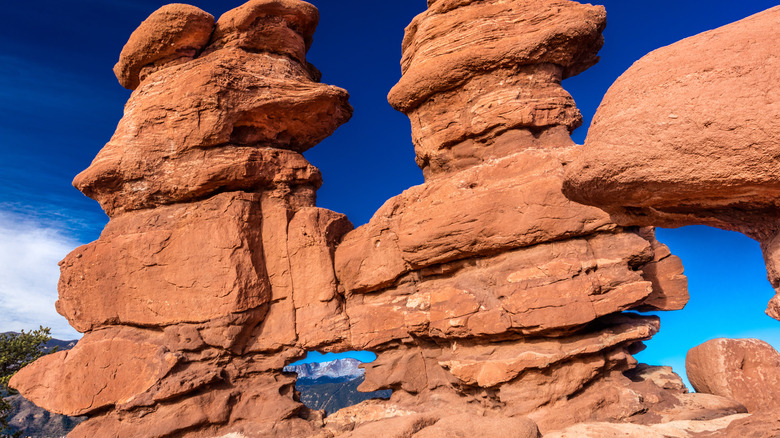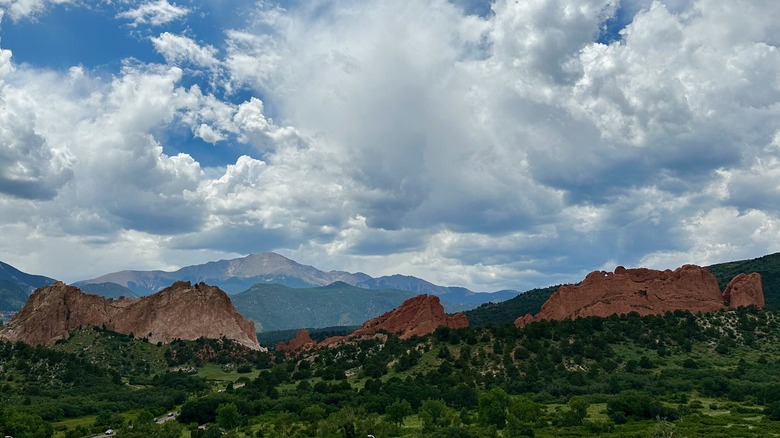This City Park In Colorado Rivals National Parks With Its Mesmerizing Red Rock Beauty
Walking amongst the striking red rock formations in Colorado Springs in the foothills of the magnificent Rocky Mountains, you could be forgiven for thinking you were in a little-known national park. But no, you're in the Garden of the Gods, a city-owned park that's free to explore. A beautiful name for a beautiful park? That's for sure.
The park's name reportedly dates to the late 1850s when two surveyors were exploring the area. One of them, Rufus Cable, referred to it as "a fit place for the gods to assemble. We will call it the Garden of the Gods," according to the Garden of the Gods Visitor & Nature Center. A few decades later, railroad baron Charles Elliott Perkins bought the land for a summer home. After he died, his children gave the land to the city for use as a public park, always free to all. Long before Cable and Perkins, the land was used by indigenous people for thousands of years— local lore says that the land was considered sacred, and indigenous people wouldn't raise their weapons against their enemies when they were there.
The Garden of the Gods is known for its incredible geologic formations, carved over millions of years by wind and water into unique shapes. Highlights include the 35-foot-tall, 700-ton Balanced Rock near the Trading Post at the southern end and the spectacular Steamboat Rock across the road. Towards the northern end of the park are the Kissing Camels.
Garden of the Gods has trails and activities for every ability
While you can see many of Garden of the Gods formations from your car, it's worth getting out and exploring on foot if you can — pack your hiking gear! The park has a total of 21 miles of hiking trails with a mix of paved and natural surfaces. There are guided nature walks ($5) daily that can help give you a greater understanding of the park, or you can explore on your own.
A popular and relatively easy hike takes visitors to the Siamese Twins (pictured), where you can take a photo of Pikes Peak framed by the red rocks. The Perkins Central Garden Loop is a 1.5-mile trail through some of the major formations, and it's paved without much elevation change, so it's great for families of all ages. For a more challenging hiking experience, the Outer Loop Trail takes you about 6.5 miles around the entirety of the park. What's nice is that there are many intersecting trails, so you can mix and match depending on what you want to see and how far you want to go. Some of the trails are open for horses, so watch your step!
As you might guess from its geology, the park has a number of fun rock-climbing routes. Take note that you must get a free permit to climb, and no chalk is allowed to help preserve the rocks.
Learn about the history and ecology of the area
To get a trail map and climbing permit plus a better understanding of the cultural, geologic, and ecological aspects of Garden of the Gods, make sure to stop by the Visitor and Nature Center on the eastern side. There are educational exhibits, including one about the never-before-known dinosaur that was discovered there. You'll also find a gift shop and cafe with views of the park.
The Visitor Center is where you can sign up for a guided park tour. Take your pick from a restored 1909 Trolley, safari-style truck, Segway, horse, or e-bike. While the park is free, these tours do have a cost. During the summer, the Rock Ledge Ranch Historic Site at Garden of the Gods runs a living history experience where you can get insight into the lives of the individuals who have called this area home, from the Ute people to homesteaders of the 19th century.
It gets particularly crowded on weekends and holidays, especially in the summer. To help keep as many cars off the park roads and to make it easy for people to get around, there is a free summer shuttle service, which runs on a loop between four of the park's biggest points of interest. Garden of the Gods is open year-round, between 5 a.m. and 9 p.m. from November 1 to April 30 and until 10 p.m. from May 1 to October 31. The Visitor Center is closed on Thanksgiving, Christmas, and New Year's Day.


